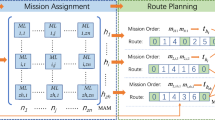Abstract
The aim of this paper was to analyse and model the behaviour decision-making of rescue crews in multi-helicopter collaborative search and rescue mission. Firstly, based on decision field theory, a dynamic behavioural decision-making model was put forward considering personal behaviour decision-making preference. Besides, considering physical characteristics, safety requirements and rescue crews’ behaviour decision-making, a multi-helicopter collaborative search and rescue behaviour model was established. Then, based on the survey of four general aviation helicopter search and rescue companies, the search and rescue efficiency by teams composed of different decision-making preferences was simulated based on distributed ant colony algorithm in experiments. Results showed that rescue crews with different personal preferences have different behaviour characteristics. Besides, teams composed of mixed preferences are more efficient than teams composed of single preferences, and the most optimal composition way is when the positive type is slightly more than the conservative type and balanced type.









Similar content being viewed by others
References
Abdelgader AMS, Wu L, Nasr MMM (2016) A simplified mobile ad hoc network structure for helicopter communication. Int J Aerosp Eng. https://doi.org/10.1155/2016/2132941
Andruszkow H, Schweigkofler U, Lefering R, Frey M, Horst K, Pfeifer R et al (2016) Impact of helicopter emergency medical service in traumatized patients: which patient benefits most? PLoS ONE 11(1):e0146897. https://doi.org/10.1371/journal.pone.0146897
Gondaliya N, Kathiriya D (2014) An application of ad hoc networks in disaster area for search and rescue operation: a survery and challenges. Int J Adv Res Comput Commun Eng 3(3):5711–5714
Okuno Y, Kobayashi K, Ishii H (2016) Development of a helicopter operations management system for disaster relief missions. J Am Helicopter Soc 61(1):1–9. https://doi.org/10.4050/JAHS.61.012006
Toda M (1962) The design of a fungus-eater: a model of human behaviour in an unsophisticated environment. Behav Sci 7(2):164–183. https://doi.org/10.1002/bs.3830070203
Brehmer B, Allard R (1991) Dynamic decision making: the effects of task complexity and feedback delay. In: Rasmussen J, Brehmer B, Leplat J (eds) New technologies and work. Distributed decision making: cognitive models for cooperative work. Wiley, Oxford, pp 319–334
Anzai Y (1984) Cognitive control of real-time event-driven systems. Cogn Sci 8(3):221–254. https://doi.org/10.1016/S0364-0213(84)80002-6
Kahneman D, Tversky A (2013) Prospect theory: an analysis of decision under risk. Handb Fundam Financ Decis Mak Part I. https://doi.org/10.1142/9789814417358_0006
Busemeyer JR, Townsend JT (1993) Decision field theory: a dynamic-cognitive approach to decision making in an uncertain environment. Psychol Rev 100(3):432
Gonzalez C, Lerch JF, Lebiere C (2003) Instance-based learning in dynamic decision making. Cogn Sci 27(4):591–635. https://doi.org/10.1016/S0364-0213(03)00031-4
Wang Z, Liang L (1998) A study on dynamic framing effects in risky decision. Acta Psychol Sin 30(04):394–400
Gray R, Franci A, Srivastava V et al (2018) Multi-agent decision-making dynamics inspired by honeybees. IEEE Trans Control Netw Syst 5(2):793–806. https://doi.org/10.1109/TCNS.2018.2796301
Valente J, Barrientos A, Del Cerro J, Rossi C, Colorado J, Sanz D et al (2011) Multi-robot visual coverage path planning: geometrical metamorphosis of the workspace through raster graphics based approaches. In: International Conference on Computational Science and Its Applications. Springer, Berlin, pp 58–73. https://doi.org/10.1007/978-3-642-21931-3_5
Rasche C, Stern C, Kleinjohann L, Kleinjohann B (2011) A distributed multi-UAV path planning approach for 3D environments. In: 2011 5th International Conference on Automation, Robotics and Applications (ICARA). IEEE, pp 7–12. https://doi.org/10.1109/ICARA.2011.6144847
Peng H, Li Y, Wang L, Shen L (2008) Hormone-inspired cooperative control for multiple UAVs wide area search. In: Advanced Intelligent Computing Theories and Applications, with Aspects of Theoretical and Methodological Issues, pp 808–816. https://doi.org/10.1007/978-3-540-87442-3_99
Galceran E, Carreras M (2013) A survey on coverage path planning for robotics. Robot Auton Syst 61(12):1258–1276. https://doi.org/10.1016/j.robot.2013.09.004
Chen Y (2007) Ant colony optimization theory applied to UAV tactical control problem. PhD thesis, National University of Defense Technology, Changsha
Beck Z, Teacy WTL, Rogers A et al (2018) Collaborative online planning for automated victim search in disaster response. Robot Auton Syst 100:251–266. https://doi.org/10.1016/j.robot.2017.09.014
Yanmaz E, Yahyanejad S, Rinner B et al (2018) Drone networks: communications, coordination, and sensing. Ad Hoc Netw 68:1–15. https://doi.org/10.1016/j.adhoc.2017.09.001
Roe RM, Busemeyer JR, Townsend JT (2001) Multialternative decision field theory: a dynamic connectionst model of decision making. Psychol Rev 108(2):370. https://doi.org/10.1037/0033-295X.108.2.370
Gao F (2013) Study on methods and applications for process-oriented dynamic decision making. PhD thesis, Huazhong University of Science and Technology, Wuhan
Ju F (2007) Investigation of airplane cockpit design based on ergonomics. PhD thesis, Northwestern Polytechnical University, Xi’an
Busemer JR, Diederich A (2002) Survey of decision field theory. Math Soc Sci 43:345–370. https://doi.org/10.1016/S0165-4896(02)00016-1
Acknowledgements
The authors acknowledge the National Key R&D Program of China (No.2018YFC0809500) and National Natural Science Foundation of China (Grant No.71573122 and No.71874081).
Author information
Authors and Affiliations
Corresponding author
Rights and permissions
About this article
Cite this article
Shao, Q., Jia, M., Xu, C. et al. Multi-helicopter collaborative search and rescue operation research based on decision-making. J Supercomput 76, 3231–3251 (2020). https://doi.org/10.1007/s11227-018-2555-7
Published:
Issue Date:
DOI: https://doi.org/10.1007/s11227-018-2555-7




